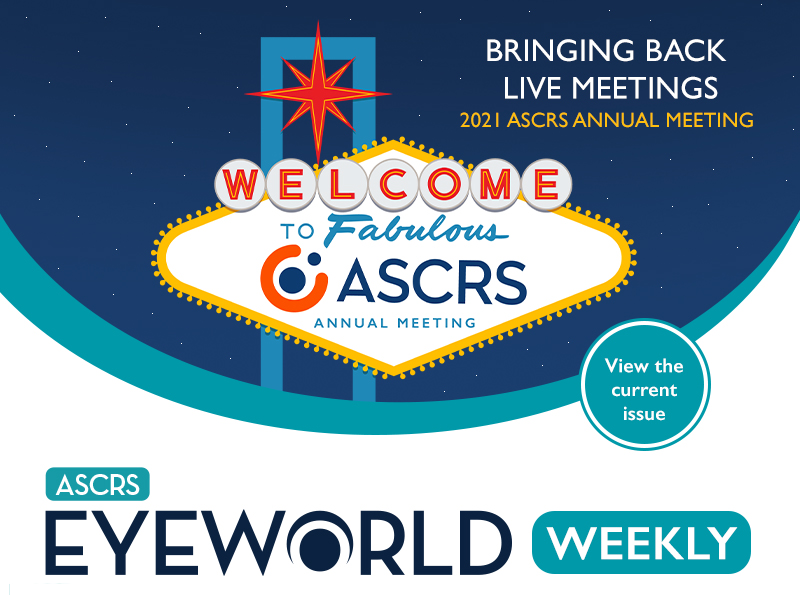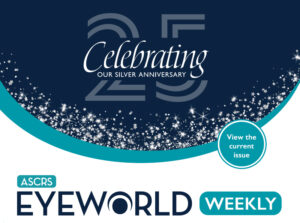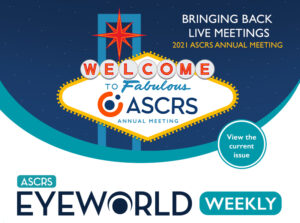
- FDA grants De Novo authorization for new intense pulsed light device
- Post-approval study requirements fulfilled for clear corneal incision sealant
- Interim analysis for acute adenoviral conjunctivitis drug
- NDA resubmission for injection to treat macular edema associated with uveitis
- FDA approves abbreviated NDA for glaucoma drug
- Study: Functional and psychosocial impact of Demodex blepharitis
- Next ASCRS Journal Club on May 13
May 7, 2021 • Volume 27, Number 18
FDA grants De Novo authorization for new intense pulsed light device
Lumenis announced De Novo authorization from the FDA for its latest intense pulsed light device, OptiLight, for improving signs of dry eye due to MGD. According to the company’s press release, Lumenis supported a multicenter, double-blinded, randomized controlled trial that showed its technology significantly improved tear breakup time, meibum quality, and meibomian gland expressibility. The research, according to the company, supports findings of prior studies that have also shown a reduction of inflammatory markers with treatment.
Post-approval study requirements fulfilled for clear corneal incision sealant
Ocular Therapeutix reported its fulfillment of the FDA’s post-approval study requirements for ReSure Sealant. The latest study was a retrospective analysis comparing endophthalmitis rates from sites that purchased ReSure Sealant vs. those that did not, according to the company. The press release stated that there were not clinically or statistically significant differences in incidence of endophthalmitis among sites that had access to ReSure compared to those that didn’t. With the findings from this and a prior clinical post-approval study, the company will submit a PMA supplement to modify the existing ReSure label.
Interim analysis for acute adenoviral conjunctivitis drug
Okogen announced interim analysis of its Phase 2, double-masked, placebo-controlled clinical trial evaluating OKG-0301 in patients with acute adenoviral conjunctivitis. Patients enrolled in the study (n=58) were assigned to one of three groups: one of the two OKG-0301 dose groups or control. Topical eye drops were administered four times a day for 5 days. OKG-0301 in the interim analysis was found to be well tolerated with no adverse drug-related events. The drug demonstrated a statistically significant antiviral effect, reducing viral titers, at day 7, compared to placebo. A dose-dependent response was observed in evaluating viral eradication, according to the company’s press release. The company plans for a Phase 3 program to start in 2022.
NDA resubmission for injection to treat macular edema associated with uveitis
ClearSide Biomedical announced the resubmission of its NDA to the FDA for XIPERE (triamcinolone acetonide suprachoroidal injectable suspension) for the treatment of macular edema associated with uveitis. According to the press release, this resubmission should have a 6-month review timeline. The company described XIPERE as a non-surgical, office-based treatment.
FDA approves abbreviated NDA for glaucoma drug
Alembic Pharmaceuticals announced FDA approval for its abbreviated NDA for dorzolamide hydrochloride and timolol maleate ophthalmic solution USP. Alembic’s combination drug is described as therapeutically equivalent to Cosopt (Akorn Pharmaceuticals), the reference listed drug.
Study: Functional and psychosocial impact of Demodex blepharitis
A survey of more than 300 patients enrolled in a Phase 2b/3 trial by Tarsus Pharmaceuticals evaluated the functional and psychosocial impact of having Demodex blepharitis. Enrollees had presence of Demodex mites, collarettes on the lashes, and lid margin erythema. According to the company’s press release, the survey asked patients about ocular symptoms, diagnosis, history, and psychosocial burdens of Demodex blepharitis. According to the survey, 51% of patients reported having signs and symptoms of blepharitis for at least 4 years but 58% had not been diagnosed, even though a third of these patients made two or more visits to doctors for evaluation. The most bothersome symptoms were itchy, dry eyes. There was an emotional component with 47% of those surveyed saying they were conscious of their eyes all day, 23% constantly worrying about their eyes, and 23% thinking it gave their eyes or eyelids a negative appearance to others. Nearly 47% of participants said they had difficulty with night driving, and 30% reported that it added time to their daily hygiene routine. Eighty-one percent had sought treatment, but many discontinued it due to inefficacy, tolerability issues, etc.
Next ASCRS Journal Club on May 13
Plan to join ASCRS’ interactive Journal Club on Thursday, May 13, from 9:00–10:00 p.m. ET for another session in a monthly series in which a panel of experts will discuss two pre-selected manuscripts from the Journal of Cataract & Refractive Surgery. Nick Mamalis, MD, and Leela Raju, MD, co-moderate these free CME sessions, open to all ASCRS members. The May session will feature Terry Kim, MD, and Saira Khanna, MD, as discussants, and Lisa Arbisser, MD, Sumitra Khandelwal, MD, and Jeff Pettey, MD, as panelists.
Research highlights
- A paper in the British Journal of Ophthalmology reported two cases of endothelial graft rejection following inoculation with a SARS-CoV-2 mRNA vaccine. The authors wrote that they think this is the first report of a temporal association between corneal transplant rejection following COVID-19 vaccination and the first report of a DMEK rejection following any immunization. One case involved a Fuchs patient who received a COVID-19 vaccine 14 days after DMEK; she presented with graft rejection signs and symptoms 7 days after her shot. The second case involved a patient with Fuchs who had bilateral DMEK 3 and 6 years earlier; she developed simultaneous acute endothelial rejection 3 weeks after her second COVID-19 vaccine. Rejection was successfully treated in both cases with topical corticosteroids. The authors hypothesize these rejections could be the result of an allogenic response initiated by the host antibody response, and they advocated for clinicians to be aware of this potential association and consider vaccination prior to keratoplasties.
- A retrospective, comparative study evaluated safety and efficacy of the first-generation iStent (Glaukos) and second-generation iStent inject after 24 months. Eighty-two consecutive eyes were included in the study (39 iStent, 43 iStent inject). At 24 months postop, the iStent inject eyes saw a mean 26% reduction in IOP compared to 9.8% in the iStent eyes. IOP reduction in both groups was greater in eyes that had higher baseline IOP. Medication was reduced from an average of 2.19 to 0.65 in the iStent inject group (a 70.3% reduction) and from 1.74 to 0.51 in the iStent group (a 70.7% reduction). This research was published in the journal Clinical Ophthalmology.
Product news
- Alcon acquired exclusive U.S. commercialization rights to Simbrinza (brinzolamide/brimonidine tartrate ophthalmic suspension, Novartis), a fixed combination carbonic anhydrase inhibitor/alpha-2 adrenergic receptor agonist for IOP reduction.
- Alcon launched Systane Hydration Multi-Dose Preservative-Free Lubricant Eye Drops in the U.S. for patients with aqueous deficient dry eye.
This issue of EyeWorld Weekly was edited by Stacy Jablonski and Liz Hillman.
EyeWorld Weekly (ISSN 1089-0319), a digital publication of the American Society of Cataract and Refractive Surgery (ASCRS), is published every Friday, distributed by email, and posted live on Friday.
Medical Editors: Eric Donnenfeld, MD, Chief Medical Editor; Rosa Braga-Mele, MD, Cataract Editor; Clara Chan, MD, Cornea Editor; Nathan Radcliffe, MD, Glaucoma Editor; and Vance Thompson, MD, Refractive Editor
For sponsorship opportunities or membership information, contact: ASCRS • 12587 Fair Lakes Circle • Suite 348 • Fairfax, VA 22033 • Phone: 703-591-2220 • Fax: 703-591-0614 • Email: ascrs@ascrs.org
Mention of products or services in EyeWorld Weekly does not constitute an endorsement by ASCRS.
Click here to view our Legal Notice.
Copyright 2021, EyeWorld News Service, a division of ASCRSMedia. All rights reserved.



